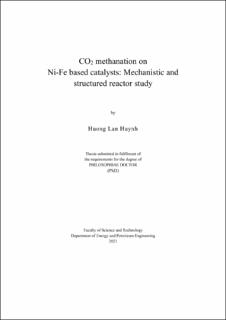| dc.contributor.author | Huynh, Huong Lan | |
| dc.date.accessioned | 2021-10-05T13:22:46Z | |
| dc.date.available | 2021-10-05T13:22:46Z | |
| dc.date.issued | 2021-10 | |
| dc.identifier.citation | CO2 methanation on Ni-Fe based catalysts: Mechanistic and structured reactor study by Huong Lan Huynh, Stavanger : University of Stavanger, 2021 (PhD thesis UiS, no. 607) | en_US |
| dc.identifier.isbn | 978-82-8439-030-7 | |
| dc.identifier.issn | 1890-1387 | |
| dc.identifier.uri | https://hdl.handle.net/11250/2787794 | |
| dc.description.abstract | The clean energy transition towards renewable energy sources has increased the need for large-scale and long-term energy storage systems. Power-to-Gas concept offers the solution to convert surplus electrical power into gaseous energy carriers. Via catalytic CO2 methanation, methane (CH4) or synthetic natural gas (SNG) can be produced from renewable H2 and captured CO2. SNG is an effective energy carrier with high heating value, and is one of the most promising chemical compounds for energy storage. Although CO2 methanation is a mature reaction, rational design and synthesis of new catalytic materials have always been necessary for the improvement of industrial process efficiency.
Based on recent advances in the development of catalysts and reactors for CO2 methanation, bimetallic Ni-Fe catalysts have been employed throughout this work. Herein, powder particle Ni-Fe/(Mg,Al)Ox catalysts were prepared from hydrotalcite (layered double hydroxides, LDHs) materials via rapid coprecipitation method. Ni-Fe alloy supported catalysts exhibited higher activity in CO2 methanation at a low temperature of 250-350 oC than Ni supported catalysts, especially at a Fe/Ni ratio of 0.25. By combining in-situ spectroscopy studies and density functional theory calculations, the promoting effect of Fe was revealed. A moderate addition of Fe alloying with Ni facilitated CO2 activation via hydrogenation to formate (*HCOO) intermediates and lowered the overall energy barrier for CH4 formation. The reaction mechanism was proposed that *CO2→*HCOO→*HCO→*CH→*CH4 was the most energetically favorable pathway for CO2 methanation over Ni-based catalysts.
Subsequently, the effect of total metal concentration on the physicochemical properties and catalytic behavior of Ni-Fe/(Mg,Al)Ox catalysts was investigated. By increasing metal concentration, a larger amount of catalyst mass per batch was produced while the catalytic activity was maintained. Hence, it is very promising possible for the large-scale production of earth-abundant Ni-Fe supported catalysts for commercial applications of CO2 methanation.
For the implementation of laboratory research into industrial practice, monolithic catalyst is commonly used because of the low pressure drop, the tunable thickness of catalytic layer, excellent heat and mass transfer and high throughput (high gas flow rates) compared to that of conventional fixed-bed catalysts. The preparation method of Ni-Fe catalysts on ceramic honeycomb substrates was developed. By urea hydrolysis, NiFe-CO3 LDHs layers were in-situ grown on the washcoated substrate, which subsequently derived to form the final Ni-Fe monolithic catalyst for CO2 methanation. Alumina colloidal solution was found to be a better washcoating material than silica. It was also found that the best performing monolithic catalysts were prepared at a metal concentration of 0.25 M.
Due to the exothermic nature of CO2 methanation, the reactor development for better heat management has been focused on. Generally, the formation of hot-spots in fixed-bed reactors could reduce CH4 yield, accelerate catalyst deactivation, and potentially cause thermal runaway. However, hot-spots could also be utilized to achieve outstanding CO2 methanation performance in monolithic reactors at low temperatures and high gas rates. Temperature profiles were examined byexperimental observation and computational fluid dynamic simulation, and hot-spot formation was identified. Due to high thermal conductivity, hot-spots were transferred along the reactor bed, thus could boost the CO2 conversion of low-activity monolithic catalysts. A strategic bed packing configuration combining low and high activity monolith was proposed. A high methane yield of ~83%, less severe hot-spot formation and stable CO2 methanation performance at high gas rates was achieved. | en_US |
| dc.language.iso | eng | en_US |
| dc.publisher | Stavanger, University of Stavanger | en_US |
| dc.relation.ispartofseries | PhD thesis UiS;607 | |
| dc.relation.haspart | Paper 1: H.L. Huynh and Z. Yu (2021) CO2 Methanation. Chapter 9 of Chemical Valorization of Carbon Dioxide (Royal Society of Chemistry book) Invited book chapter, to be submitted. This paper is not included in Brage for copyright reasons. | en_US |
| dc.relation.haspart | Paper 2: H.L. Huynh and Z. Yu (2020) CO2 Methanation on Hydrotalcite-Derived Catalysts and Structured Reactors: A Review. Energy Technology, 8, 1901475. DOI: 10.1002/ente.201901475 | en_US |
| dc.relation.haspart | Paper 3: H. L. Huynh, J. Zhu, G. Zhang, et al. (2020) Promoting effect of Fe on supported Ni catalysts in CO2 methanation by in situ DRIFTS and DFT study. Journal of Catalysis, 392, pp. 266-277. DOI: 10.1016/j.jcat.2020.10.018 | en_US |
| dc.relation.haspart | Paper 4: H. L. Huynh, W. M. Tucho, X. Yu, and Z. Yu (2020) Synthetic natural gas production from CO2 and renewable H2: Towards large-scale production of Ni-Fe alloy catalysts for commercialization. Journal of Cleaner Production, 264, 121720. DOI: 10.1016/j.jclepro.2020.121720 | en_US |
| dc.relation.haspart | Paper 5: H. L. Huynh, W. M. Tucho, and Z. Yu (2020) Structured NiFe catalysts derived from in-situ grown layered double hydroxides on ceramic monolith for CO2 methanation. Green Energy & Environment, 5, pp. 423-432. DOI: 10.1016/j.gee.2020.09.004 | en_US |
| dc.relation.haspart | Paper 6: H. L. Huynh, W. M. Tucho, Q. Shen and Z. Yu (2022) Bed packing configuration and hot-spot utilization for lowtemperature CO2 methanation on monolithic reactor. Chemical Engineering Journal, 428, 131106. DOI: 10.1016/j.cej.2021.131106 | en_US |
| dc.rights | Attribution-NonCommercial-NoDerivatives 4.0 Internasjonal | * |
| dc.rights.uri | http://creativecommons.org/licenses/by-nc-nd/4.0/deed.no | * |
| dc.subject | fornybar energi | en_US |
| dc.subject | energi | en_US |
| dc.subject | naturgass | en_US |
| dc.subject | CO2 methanation | en_US |
| dc.title | CO2 methanation on Ni-Fe based catalysts: Mechanistic and structured reactor study | en_US |
| dc.type | Doctoral thesis | en_US |
| dc.rights.holder | ©2021 Huong Lan Huynh | en_US |
| dc.subject.nsi | VDP::Teknologi: 500::Berg‑ og petroleumsfag: 510::Petroleumsteknologi: 512 | en_US |

